Fundamentals of Geomagnetism | Geography Optional for UPSC PDF Download
| Table of contents |

|
| Introduction |

|
| Magnetic Poles & Geomagnetic Poles |

|
| Geomagnetic Reversal |

|
| Theories about origin of earth’s magnetism |

|
| Frequently Asked Questions (FAQs) of Fundamentals of Geomagnetism |

|
Introduction
Geomagnetism is a relatively recent field of study in geomorphology that has significantly expanded our understanding of geological processes and the Earth's interior. This area of study is attributed to William Gilbert and focuses on the dynamics of the Earth's magnetic field, which originates in the outer core.
- The Earth's magnetic field primarily acts as a geo-axial dipole, with its north and south magnetic poles located near the geographic poles. Throughout the Earth's geological history, its magnetic field has shifted and reversed, typically at a slow rate of around 9 km per year. However, since the beginning of the 21st century, this speed has accelerated to 50 km per year.
- The Earth functions as a dipole magnet, with its geomagnetic south pole near the Earth's geographic north and vice versa. The magnetosphere, the region where the Earth's magnetic field can be detected, extends around 60,000 km above the Earth's surface. This magnetic field reaches up to 3,200 km away from the Earth's surface, helping to deflect solar wind and protect the planet from potential catastrophes.
- The Earth's magnetic field serves as a shield against solar flares and harmful gamma rays from the sun. Interestingly, there have been periods in the Earth's geological past when its magnetic field disappeared, and these periods often coincide with major extinction events on the planet.
In summary, geomagnetism is a vital area of study that investigates the Earth's magnetic field and its impacts on the planet's geological processes and protection from cosmic threats. The field has contributed greatly to our understanding of the Earth's interior and the dynamics of its magnetic field, which is crucial for the planet's safety and preservation.
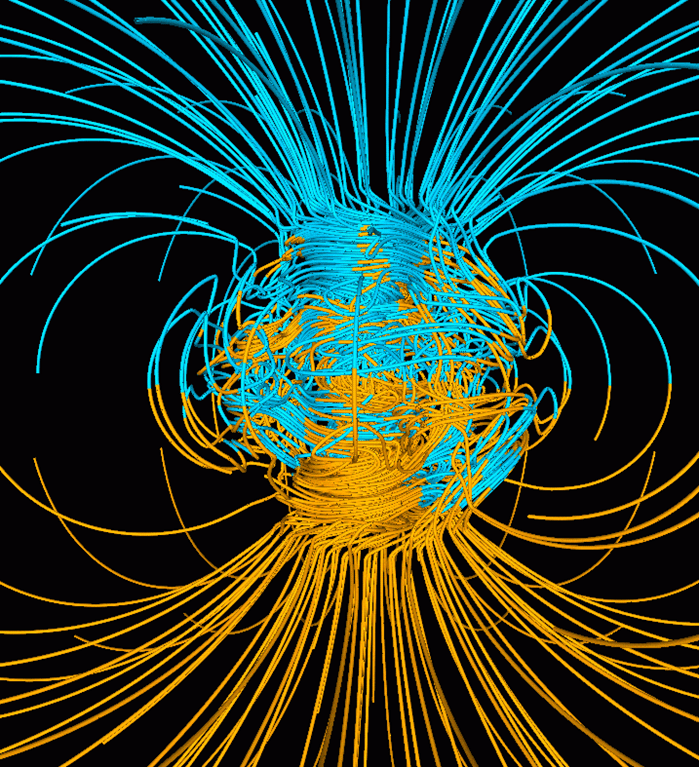 Earth’s Magnetic Field
Earth’s Magnetic Field
Magnetic Poles & Geomagnetic Poles
Magnetic Poles and Geomagnetic Poles are two terms used to describe different aspects of Earth's magnetic field.- A magnet's North pole is the pole that is attracted to Earth's North Magnetic Pole when allowed to rotate freely. Since opposite poles attract each other, Earth's North Magnetic Pole is actually the south pole of its own magnetic field. Earth's magnetic field, which resembles a simple bar magnet's north-south field, is typically closely aligned with its rotational axis.
- This means that the magnetic poles are usually quite close to the geographic poles (the poles through which Earth's axis passes), which is why compasses work effectively.
- However, the magnetic field's dipole component reverses every few thousand years, causing the locations of the north and south magnetic poles to switch. Currently, Earth's magnetic North Pole is rapidly moving from the Canadian Arctic towards Russia.
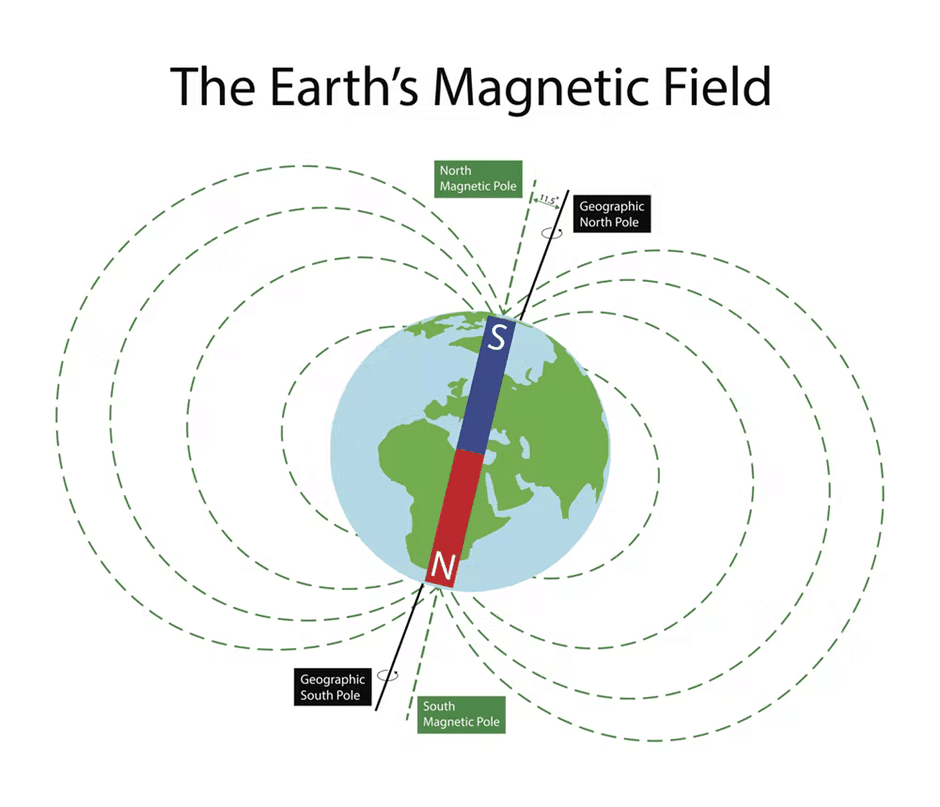 Earth’s Magnetic Field
Earth’s Magnetic Field
- On the other hand, Geomagnetic Poles refer to the points where Earth's surface intersects with the axis of a hypothetical bar magnet placed at Earth's center.
- There is one such pole in each hemisphere, known as the "geomagnetic north pole" and the "geomagnetic south pole."
- The geomagnetic dipole is currently tilted at an angle of about 11 degrees to Earth's rotational axis. The magnetic poles, however, are the points where magnetic needles become vertical.
- The difference in positions between the magnetic poles and geomagnetic poles is due to Earth's uneven and complex magnetic field distribution.
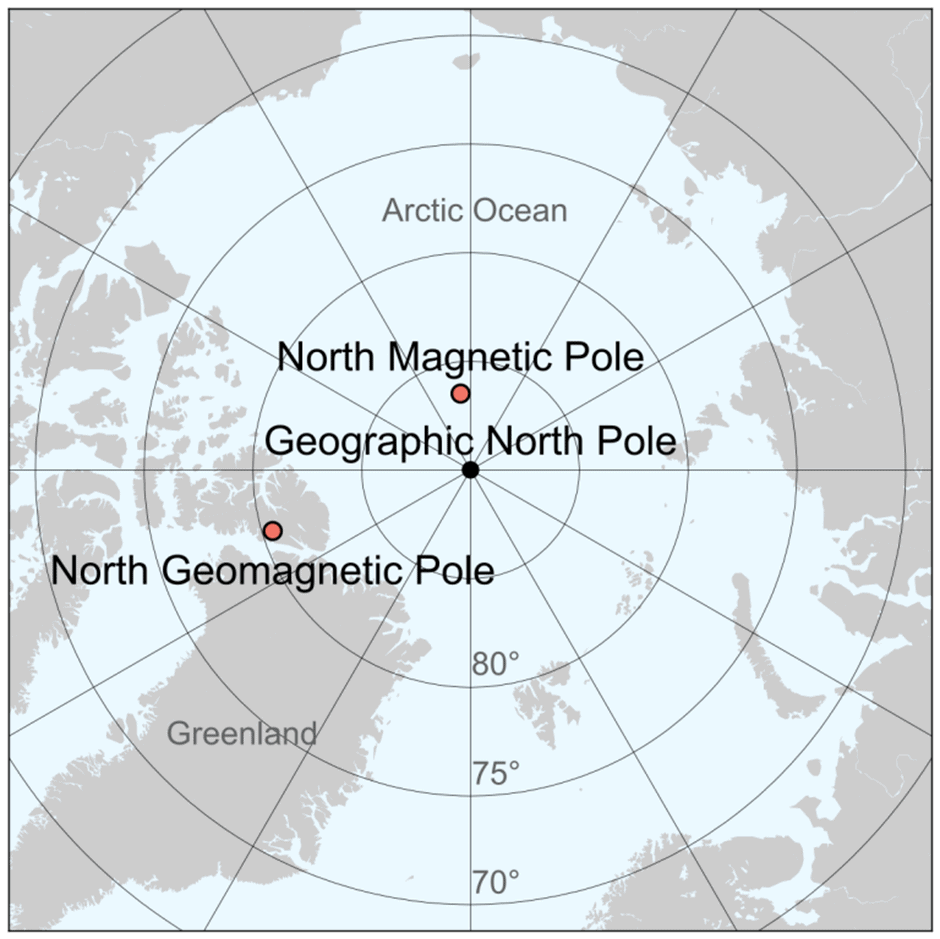 North Pole
North Pole
- Geomagnetic poles are antipodal points where the axis of a best-fitting dipole intersects Earth's surface.
- This theoretical dipole is akin to a powerful bar magnet at Earth's center and provides the most accurate model for describing the magnetic field observed on Earth's surface. In contrast, Earth's actual magnetic poles are not antipodal, meaning the line connecting them does not pass through Earth's center.
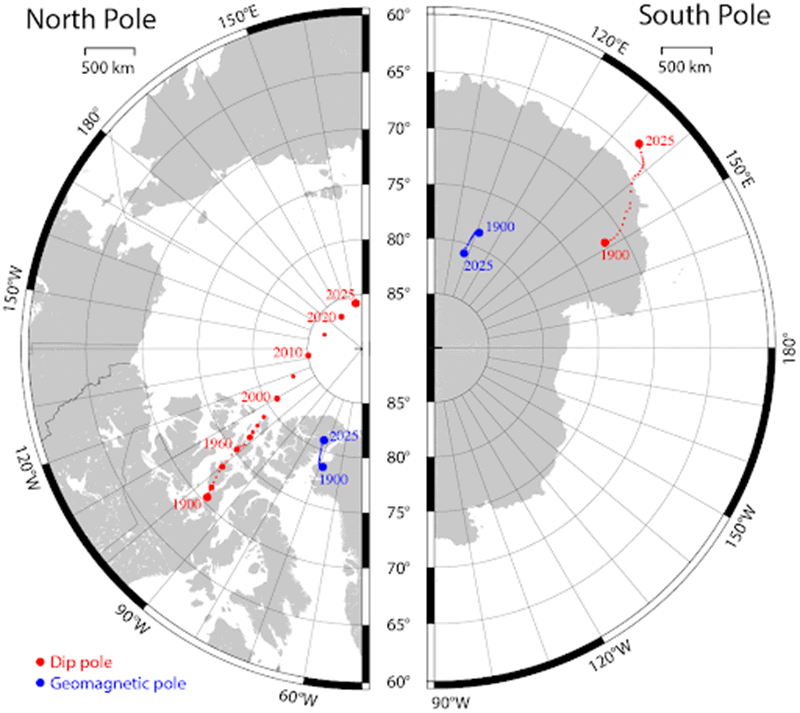 Magnetic Pole
Magnetic Pole
Geomagnetic Reversal
A geomagnetic reversal refers to a change in the Earth's magnetic field where the positions of magnetic north and magnetic south switch places. This phenomenon has been studied through paleomagnetism, which examines the magnetism in rocks formed under the influence of Earth's magnetic field at the time of their creation. Over the past 20 million years, it has been observed that the magnetic north and south poles have flipped approximately every 200,000 to 300,000 years.- However, the reversal process is not as regular as the sun's magnetic field, which reverses every 11 years. On Earth, the time between magnetic reversals can range from as short as 10,000 years to as long as 25 million years, and the reversal process itself can take anywhere from a few hundred to a few thousand years. Throughout the reversal, the magnetic poles emerge at unusual latitudes.
- The Earth's magnetic field has experienced periods of normal polarity, where the predominant direction is the same as it is today, and reverse polarity, where the direction is opposite. The North and South Magnetic Poles shift due to changes in the Earth's magnetic field, and their locations are not fixed. Currently, the North Magnetic Pole is located in northern Canada and is rapidly drifting towards Siberia, while the South Magnetic Pole is positioned off the coast of Antarctica.
- Scientists estimate that the North Magnetic Pole moves about 10 kilometers per year, but recently, its speed has increased to around 50 kilometers per year, potentially reaching Siberia within a few decades. Since the Earth's magnetic field is not perfectly symmetrical, the North and South Magnetic Poles do not have antipodal positions, meaning a straight line drawn between them does not pass through the Earth's center.
- The Earth's North and South Magnetic Poles are also referred to as Magnetic Dip Poles due to the vertical "dip" of the magnetic field lines at these points. For example, if a magnetic compass needle is freely suspended at the magnetic poles, it will point straight down at the North Magnetic Pole (the south pole of Earth's magnetic field) and straight up at the South Magnetic Pole (the north pole of Earth's magnetic field).
Sunspot Theory
- The Sunspot Theory suggests that the Sun, being a massive magnet, can have a significant impact on Earth's magnetic field during periods of increased sunspot activity. When the Sun's magnetic field is waxing or becoming stronger, the solar wind can penetrate Earth's magnetic shield and interact with the planet's magnetic field, provided that Earth's magnetism is in a waning or weakening phase. In this way, Earth can potentially acquire the Sun's magnetic polarity.
- Furthermore, collisions with meteorites or comets can cause a reversal of Earth's magnetic poles. When these impacts occur, the Earth's magnetic field can become temporarily disrupted and lose its magnetism. As the magnetism re-establishes, the magnetic poles may reverse. This process suggests that external factors, such as solar activity and celestial collisions, can play a significant role in the behavior of Earth's magnetic field.
Magnetic Declination
- Magnetic Declination, also known as the horizontal component, refers to the angle on the horizontal plane between magnetic North and geographic (true) North. By convention, the declination is considered positive when magnetic North is east of true North, and negative when it is to the west. Currently, the magnetic North Pole is slightly west of the geographic North Pole, while the magnetic South Pole is slightly east of the geographic South Pole. This is due to the molten, iron-rich core of the Earth, which spins like a dynamo and causes a gradual westward drift of the geomagnetic field, resulting in ever-changing magnetic declination throughout Earth's geological history. Magnetic declination can be measured using a magnetic compass.
- Magnetic Inclination, also known as Dip Angle or Magnetic Dip, is the vertical component of geomagnetism. It is defined as the angular inclination between a freely suspended magnetic needle and the Earth's horizontal surface. The magnetic dip occurs due to a magnet's tendency to align itself with the line of force. As latitude increases, the dip angle also increases, reaching 90 degrees at the magnetic poles and 0 degrees at the magnetic equator. The inclination can be measured using a dip needle.
- The Magnetic Equator is the line or locus of points where the dip angle is zero, meaning the magnetic force is perfectly horizontal at these locations.
Theories about origin of earth’s magnetism
There are several theories about the origin of Earth's magnetism:- Gilbert Theory: Sir Gilbert first discovered Earth's magnetism in the 1600s. He believed that a bar magnet inside the Earth's interior was responsible for the magnetism. However, this theory is not widely accepted, as it cannot explain how the bar magnet's magnetism could sustain itself in the high temperatures and molten rocks of the Earth's interior. It also cannot explain the periodic reversal of Earth's magnetic polarity without assuming the rotation of the magnet itself, which is improbable.
- Rock Magnetism: Another theory suggests that Earth's magnetism is due to rock magnetism. While rock magnetism does exist, it is not considered the primary cause of Earth's geomagnetism, as randomly created magnetic rocks cannot explain the specific orientation of Earth's magnetic field. Additionally, the high temperatures of the Earth's interior should have destroyed any magnetism, as no magnetism can maintain itself in such extreme heat and molten fluid state.
- Dynamo Theory: In 1939, Walter Alsec proposed the Dynamo theory, which states that Earth's magnetism may be the result of the unique structure of Earth's core. The core consists of an iron-rich solid inner core, which is magnetic, and an outer core that is hot and fluid, with free electrons in a near plasma state. Due to Earth's rotation, the outer core and its free electrons also rotate around the inner core, creating electricity. This arrangement is called a solenoid. The solenoid generates a magnetic field, which in turn induces a strong electric field, further strengthening the magnetic field. This self-exciting dynamo mechanism is the most widely accepted explanation for Earth's magnetism. However, it is still unable to explain the fluctuation in the magnetic field and reversal of polarity. Even though Earth's rotation has been smooth and consistent throughout its geological history, the Earth's spin has never reversed.
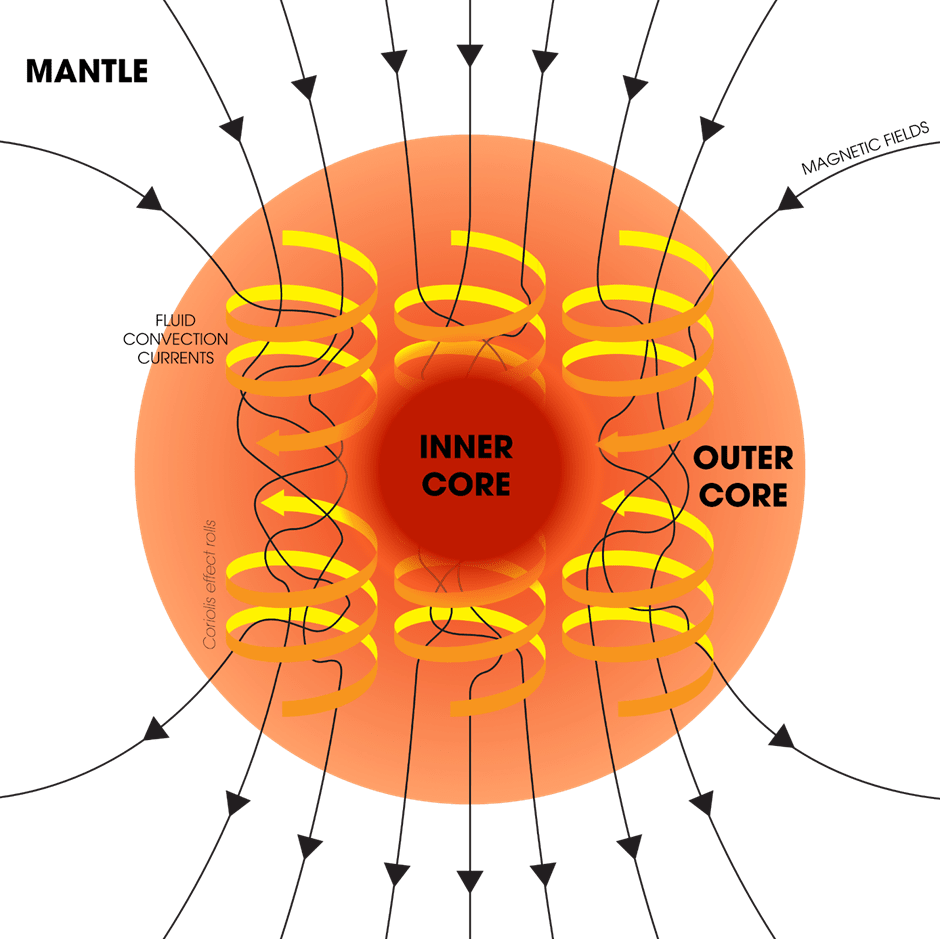 Dynamo Theory
Dynamo Theory
Conclusion
Geomagnetism is a crucial field of study that enhances our understanding of Earth's magnetic field and its role in geological processes and protection from cosmic threats. The Earth's magnetic field, which primarily functions as a geo-axial dipole, has experienced shifts and reversals throughout its history, impacting the planet's magnetic poles and geomagnetic poles. The widely accepted Dynamo Theory attributes the origin of Earth's magnetism to the unique structure and behavior of the planet's core. Studying Earth's magnetic field and its fluctuations can provide valuable insights into the dynamics of the planet's interior and help predict future changes that may affect the planet's safety and preservation.Frequently Asked Questions (FAQs) of Fundamentals of Geomagnetism
What is geomagnetism, and why is it important?
Geomagnetism is the study of Earth's magnetic field and its impacts on the planet's geological processes and protection from cosmic threats. It is crucial for understanding the Earth's interior, the dynamics of its magnetic field, and the protection it provides from solar flares and harmful gamma rays.
What is the difference between Magnetic Poles and Geomagnetic Poles?
Magnetic Poles refer to the points on Earth's surface where the magnetic field lines are vertical, near the geographic poles. Geomagnetic Poles, on the other hand, are the points where Earth's surface intersects with the axis of a hypothetical bar magnet placed at Earth's center. The magnetic poles are subject to change and movement, while the geomagnetic poles are more stable and theoretical in nature.
What is a geomagnetic reversal, and how often does it occur?
A geomagnetic reversal is a change in Earth's magnetic field where the positions of magnetic north and magnetic south switch places. Over the past 20 million years, the magnetic north and south poles have flipped approximately every 200,000 to 300,000 years. However, the reversal process is not regular, and the time between reversals can range from as short as 10,000 years to as long as 25 million years.
What is the Dynamo Theory, and how does it explain Earth's magnetism?
The Dynamo Theory suggests that Earth's magnetism is a result of the unique structure of Earth's core, which consists of an iron-rich solid inner core and a hot, fluid outer core with free electrons. Due to Earth's rotation, the outer core and its free electrons also rotate around the inner core, creating electricity and generating a magnetic field. This self-exciting dynamo mechanism is the most widely accepted explanation for Earth's magnetism.
What is magnetic declination, and how is it measured?
Magnetic declination is the angle on the horizontal plane between magnetic North and geographic (true) North. It is considered positive when magnetic North is east of true North and negative when it is to the west. Magnetic declination can be measured using a magnetic compass and is crucial for navigation, as it allows for the correction of compass readings to account for the difference between magnetic and true North.
|
303 videos|636 docs|252 tests
|
FAQs on Fundamentals of Geomagnetism - Geography Optional for UPSC
| 1. What are magnetic poles and geomagnetic poles? |  |
| 2. What is geomagnetic reversal? |  |
| 3. What are some theories about the origin of Earth's magnetism? |  |
| 4. How does geomagnetism impact our daily lives? |  |
| 5. How do scientists study geomagnetism? |  |
















